Está querendo mudar o WordPress de HTTP para HTTPS e instalar um certificado SSL em seu site?
Recebemos muitas solicitações sobre esse tópico porque o Google anunciou em julho de 2018 que o navegador Chrome marcaria todos os sites sem SSL como inseguros.
Neste artigo, mostraremos como mover corretamente o WordPress de HTTP para HTTPS adicionando um certificado SSL.
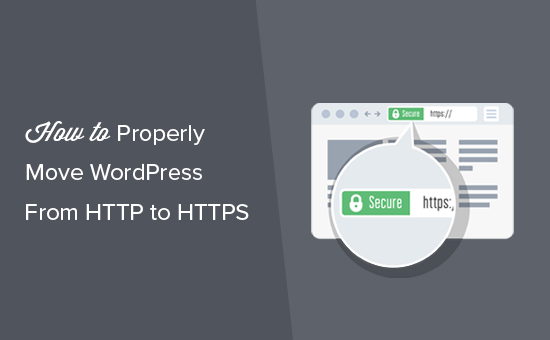
Não se preocupe se você não tem ideia do que é SSL ou HTTPS. Nós também explicaremos isso.
O que é HTTPS?
HTTPS ou HTTP seguro é um método de criptografia que protege a conexão entre o navegador dos usuários e o seu servidor. Isso torna mais difícil para os hackers espionarem a conexão.
Todos os dias, compartilhamos nossas informações pessoais com diferentes sites, seja para fazer uma compra ou simplesmente para fazer login.
Para proteger a transferência de dados, é necessário criar uma conexão segura.
É aí que entram em cena o SSL e o HTTPS.
Cada site recebe um certificado SSL exclusivo para fins de identificação. Se um servidor estiver fingindo estar em HTTPS e seu certificado não corresponder, a maioria dos navegadores modernos advertirá o usuário para que não se conecte ao site.
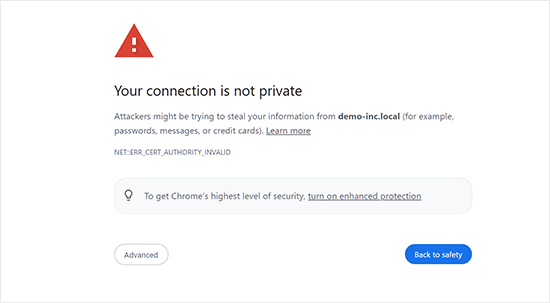
Agora, você deve estar se perguntando por que preciso mudar meu site WordPress de HTTP para HTTPS, especialmente se for um blog simples ou um site de uma pequena empresa que não recebe pagamentos.
Por que você precisa de HTTPS e SSL?
Em 2018, o Google anunciou um plano para melhorar a segurança geral da Web, incentivando os proprietários de sites a mudar de HTTP para HTTPS. Como parte desse plano, seu popular navegador Chrome marcaria todos os sites sem um certificado SSL como “Não seguro”.
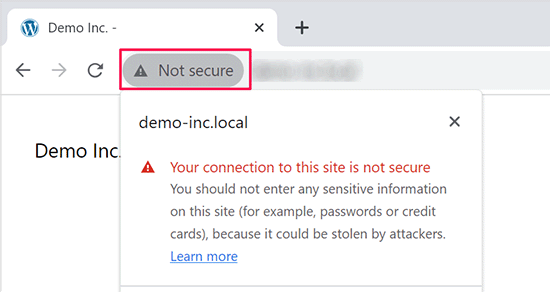
O Google também disse que os sites com SSL também terão benefícios de SEO e obterão classificações de pesquisa mais altas do que os sites inseguros. Desde então, um grande número de sites mudou de HTTP para HTTPS.
Após o anúncio, o Google começou a implementar o aviso “Not Secure” no Chrome. Por exemplo, se alguém visitar um site HTTP usando a janela anônima, ele será marcado como Não seguro. Se alguém visitar um site HTTP no modo normal e tentar preencher um formulário de contato ou outro formulário, o site será marcado como inseguro.
Quando seus leitores e clientes veem esse aviso, eles têm uma má impressão de sua empresa.
É por isso que todos os sites precisam mudar de HTTP para HTTPS e instalar o SSL imediatamente.
Sem mencionar que, se você quiser aceitar pagamentos on-line no seu site de comércio eletrônico, precisará de SSL.
A maioria das empresas de pagamento, como Stripe, PayPal Pro, Authorize.net, etc., exigirá uma conexão segura antes de aceitar pagamentos.
Usamos SSL em nossos sites, incluindo WPBeginner, OptinMonster, WPForms e MonsterInsights.
Requisitos para usar HTTPS/SSL em um site WordPress
Os requisitos para usar o SSL no WordPress não são muito altos. Tudo o que você precisa fazer é comprar um certificado SSL, e talvez você já o tenha gratuitamente.
As melhores empresas de hospedagem WordPress estão oferecendo certificados SSL gratuitos para todos os seus usuários:
Para obter mais detalhes, consulte nosso guia sobre como obter um certificado SSL gratuito para seu site WordPress.
Se a sua empresa de hospedagem não oferecer um certificado SSL gratuito, você precisará comprar um certificado SSL.
Recomendamos usar o Domain.com porque ele oferece a melhor oferta de SSL para certificados SSL regulares e curinga.
Ao adquirir um certificado SSL deles, você também recebe um selo de site TrustLogo para o seu site, e cada certificado SSL vem com uma garantia de segurança mínima de US$ 10.000.
Depois de adquirir um certificado SSL, você precisará solicitar ao provedor de hospedagem que o instale para você.
Configuração do WordPress para usar SSL e HTTPS
Depois de ativar um certificado SSL para seu nome de domínio, você precisará configurar o WordPress para usar os protocolos SSL e HTTP em seu site.
Mostraremos dois métodos para fazer isso, e você pode escolher o que melhor atende às suas necessidades.
Tutorial em vídeo
Se você preferir instruções por escrito, continue lendo
Método 1: Configurar SSL/HTTPS no WordPress usando um plug-in
Esse método é mais fácil e é recomendado para iniciantes.
Primeiro, você precisa instalar e ativar o plug-in Really Simple SSL. Para obter mais detalhes, consulte nosso guia passo a passo sobre como instalar um plug-in do WordPress.
Após a ativação, você precisa visitar a página Settings ” SSL. O plug-in detectará automaticamente seu certificado SSL e configurará seu site WordPress para usar HTTPS.
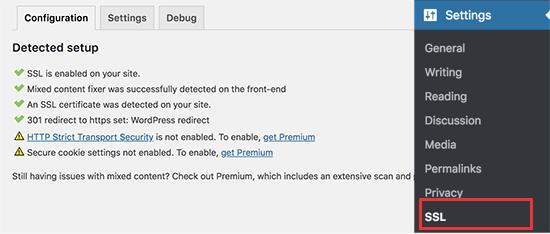
O plug-in cuidará de tudo, inclusive dos erros de conteúdo misto. Veja a seguir o que o plug-in faz nos bastidores:
- Verificar o certificado SSL
- Configure o WordPress para usar https em URLs
- Configurarredirecionamentos de HTTP para HTTPS
- Procure URLs em seu conteúdo que ainda estejam sendo carregados de fontes HTTP inseguras e tente corrigi-los.
Observação: o plug-in tenta corrigir erros de conteúdo misto usando a técnica de buffer de saída. Ele pode ter um impacto negativo no desempenho porque está substituindo o conteúdo do site enquanto a página está sendo carregada. Esse impacto é visto apenas no carregamento da primeira página e deve ser mínimo se você estiver usando um plug-in de cache.
Embora o plug-in diga que você pode manter o SSL e desativar o plug-in com segurança, isso não é 100% verdadeiro. Você terá que deixar o plug-in ativo o tempo todo, pois a desativação do plug-in trará de volta erros de conteúdo misto. Consulte nossa análise do Really Simple SSL para obter mais detalhes.
Método 2: Configurar SSL/HTTPS no WordPress manualmente
Esse método exige que você solucione os problemas manualmente e edite os arquivos do WordPress. No entanto, é uma solução permanente e mais otimizada em termos de desempenho, e estamos usando-a no WPBeginner.
Se você achar esse método difícil, poderá contratar um desenvolvedor do WordPress ou usar o primeiro método.
Como parte desse método, talvez seja necessário editar o tema e os arquivos de código do WordPress. Se você nunca fez isso antes, consulte nosso guia sobre como copiar e colar trechos de código no WordPress.
Primeiro, você precisa acessar a página Configurações ” Geral. Aqui, você precisa atualizar os campos de endereço de URL do WordPress e do site, substituindo http por https.
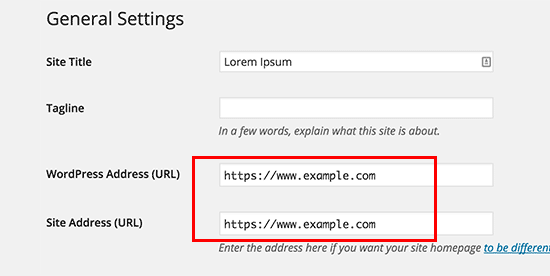
Não se esqueça de clicar no botão “Salvar alterações” para armazenar suas configurações.
Depois que as configurações forem salvas, o WordPress fará o logout e você será solicitado a refazer o login.
Em seguida, você precisa configurar os redirecionamentos do WordPress de HTTP para HTTPS adicionando o seguinte código ao seu arquivo .htaccess:
<IfModule mod_rewrite.c>
RewriteEngine On
RewriteCond %{HTTPS} off
RewriteRule ^(.*)$ https://%{HTTP_HOST}%{REQUEST_URI} [L,R=301]
</IfModule>
Se você estiver usando servidores NGINX, precisará adicionar o seguinte código para redirecionar de HTTP para HTTPS em seu arquivo de configuração:
server {
listen 80;
server_name example.com www.example.com;
return 301 https://example.com$request_uri;
}
Não se esqueça de substituir example.com por seu nome de domínio.
Ao seguir essas etapas, você evitará o erro HTTPS not working do WordPress, pois o WordPress carregará todo o seu site usando HTTPS.
Se quiser forçar o SSL e o HTTPS na área de administração ou nas páginas de login do WordPress, você precisará configurar o SSL no arquivo wp-config.php.
Adicione o seguinte código acima da linha “That’s all, stop editing!” (Isso é tudo, pare de editar! ) em seu arquivo wp-config.php:
define('FORCE_SSL_ADMIN', true);
Essa linha permite que o WordPress force SSL / HTTPs na área de administração do WordPress. Ela também funciona em redes multisite do WordPress.
Depois de fazer isso, seu site estará totalmente configurado para usar SSL/HTTPS, mas você ainda encontrará erros de conteúdo misto.
Esses erros são causados por fontes (imagens, scripts ou folhas de estilo) que ainda estão sendo carregadas usando o protocolo HTTP inseguro nos URLs. Se esse for o caso, não será possível ver um ícone de cadeado seguro na barra de endereços do seu site.

Muitos navegadores modernos bloqueiam automaticamente scripts e recursos não seguros.
Você poderá ver um ícone de cadeado, mas com uma notificação sobre isso na barra de endereços do navegador.
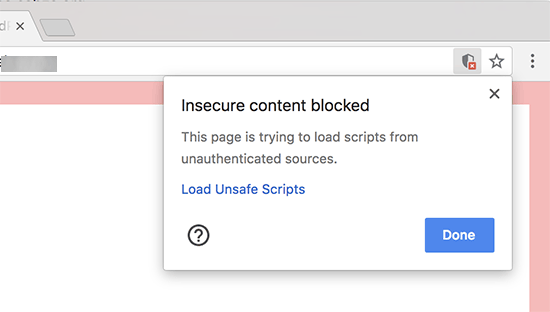
Você pode descobrir qual conteúdo é servido por meio de um protocolo inseguro usando a ferramenta Inspect.
O erro de conteúdo misto será exibido como um aviso no console com detalhes para cada item de conteúdo misto.

Você perceberá que a maioria dos URLs são imagens, iframes e galerias de imagens, enquanto alguns são scripts e folhas de estilo carregados pelos plug-ins e temas do WordPress.
Correção de conteúdo misto no banco de dados do WordPress
A maioria dos URLs incorretos será de imagens, arquivos, incorporações e outros dados armazenados no banco de dados do WordPress. Vamos corrigi-los primeiro.
Você precisa encontrar todas as menções do URL do site antigo no banco de dados que começam com http e substituí-las pelo URL do site novo que começa com https.
Você pode fazer isso facilmente instalando e ativando o plug-in Search & Replace Everything. Para obter mais detalhes, consulte nosso guia passo a passo sobre como instalar um plug-in do WordPress.
Após a ativação, você precisa acessar a página Tools ” WP Search & Replace. No campo “Search” (Pesquisar), você precisa adicionar o URL do seu site com http. Depois disso, adicione o URL do seu site com https no campo “Replace” (Substituir).

Abaixo disso, você verá todas as tabelas do banco de dados do WordPress. Você precisa selecionar todas elas para executar uma verificação completa.

Em seguida, clique no botão “Preview Search & Replace” (Visualizar pesquisa e substituição) para ver todas as alterações que o plug-in fará. Por fim, clique no botão “Replace All” (Substituir tudo).
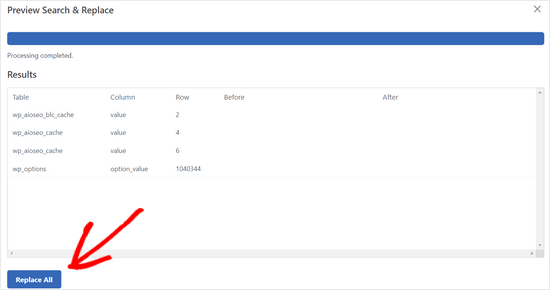
O plug-in agora pesquisará em seu banco de dados do WordPress os URLs que começam com http e os substituirá por URLs https seguros. Isso pode demorar um pouco, dependendo do tamanho do seu banco de dados do WordPress.
Correção de erros de conteúdo misto no tema do WordPress
Outro culpado comum que causa erros de conteúdo misto é o tema do WordPress. Qualquer tema decente do WordPress que siga os padrões de codificação do WordPress não causará esse problema.
Primeiro, você precisará usar a ferramenta Inspect do seu navegador para localizar os recursos e de onde eles estão sendo carregados.

Depois disso, você precisará encontrá-los em seu tema do WordPress e substituí-los por https. Isso será um pouco difícil para a maioria dos iniciantes, pois você não conseguirá ver quais arquivos de tema contêm esses URLs.
Correção de erros de conteúdo misto causados por plug-ins
Alguns recursos de conteúdo misto serão carregados por plug-ins do WordPress. Qualquer plug-in do WordPress que siga os padrões de codificação do WordPress não causará erros de conteúdo misto.
Não recomendamos a edição de arquivos de plug-in do WordPress. Em vez disso, você deve entrar em contato com o autor do plug-in e informá-lo. Se eles não responderem ou não puderem corrigir o problema, você deverá encontrar uma alternativa adequada.
Observação: se, por algum motivo, você ainda estiver encontrando um erro de conteúdo misto, recomendamos usar temporariamente o plug-in Really Simple SSL para que seus usuários não sejam afetados enquanto você corrige o problema em um site de teste ou contrata um desenvolvedor.
Envie seu site HTTPS para o Google Search Console
Mecanismos de pesquisa como o Google consideram https e http como dois sites diferentes. Para evitar problemas de SEO, você precisará informar ao Google que seu site foi transferido.
Para fazer isso, basta acessar sua conta do Google Search Console e clicar no botão “Adicionar uma propriedade”.

Isso abrirá uma janela pop-up na qual você precisará adicionar o novo endereço https do seu site.
Há dois métodos de verificação de site: nome de domínio ou prefixo de URL. Recomendamos o método do prefixo do URL porque ele é mais flexível.
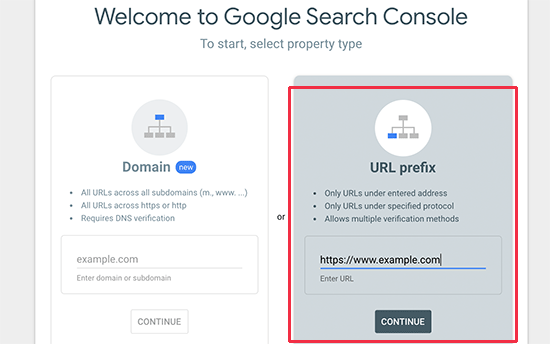
Depois disso, o Google solicitará que você verifique a propriedade do seu site.
Há várias maneiras de fazer isso. Selecione qualquer método e você receberá instruções para verificar seu site. Recomendamos usar o método de tag HTML.
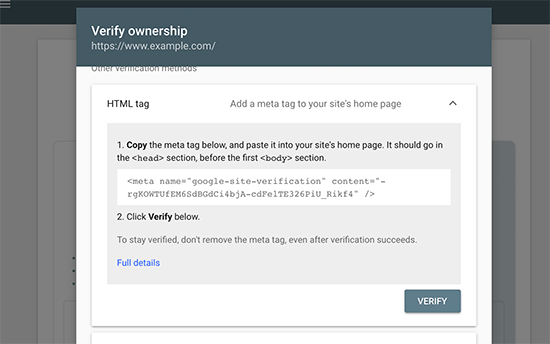
Agora você verá um trecho de código HTML que precisa ser adicionado à seção head do seu site WordPress.
Adicionar código de verificação do Search Console usando o All in One SEO
Primeiro, instale e ative o plug-in All in One SEO para WordPress. Para obter mais detalhes, consulte nosso tutorial sobre como instalar um plug-in do WordPress.
Observação: Há também uma versão gratuita do All in One SEO que você pode experimentar.
Após a ativação, vá para a página All in One SEO ” Configurações gerais e clique em Google Search Console.

Em seguida, é necessário adicionar o código de verificação que você copiou anteriormente do site do Google Search Console.
Não se esqueça de clicar no botão “Save Changes” (Salvar alterações) para armazenar suas configurações.
Em seguida, volte para a guia Google Search Console e clique no botão “Verify” (Verificar).

Depois que seu site for verificado, o Google mostrará os relatórios do console de pesquisa aqui.
Você também precisa garantir que as versões https e http sejam adicionadas ao Search Console.
Isso informa ao Google que você deseja que a versão https do seu site seja tratada como a versão principal. Combinado com os redirecionamentos 301 que você configurou anteriormente, o Google transferirá suas classificações de pesquisa para a versão https do seu site, e você provavelmente verá melhorias nas suas classificações de pesquisa.
Esperamos que este artigo tenha ajudado você a adicionar HTTPS e SSL no WordPress. Talvez você também queira ver nosso guia definitivo de segurança do WordPress com instruções passo a passo para manter seu site do WordPress seguro ou nossas escolhas de especialistas das melhores soluções de análise para WordPress.
Se você gostou deste artigo, inscreva-se em nosso canal do YouTube para receber tutoriais em vídeo sobre o WordPress. Você também pode nos encontrar no Twitter e no Facebook.





Syed Balkhi says
Hey WPBeginner readers,
Did you know you can win exciting prizes by commenting on WPBeginner?
Every month, our top blog commenters will win HUGE rewards, including premium WordPress plugin licenses and cash prizes.
You can get more details about the contest from here.
Start sharing your thoughts below to stand a chance to win!
Mrteesurez says
This is really fantastic.
Notinhy is bad as a visitors seeing a website insecured especially an ecommerce that collect online payment from users, this is definitely a bad experience.
That’s why it’s always advisable to have https Website. Choosing one of the hostings you have listed like Bluehost and others gives free SSL and free domain for the first year.
With Bluehost, you don’t need to manually installed the SSL certificate on your website.
Thanks, sharing this.
Moinuddin Waheed says
one of my clients recently purchased a shared hosting from GoDaddy and then asked to make his website.
I started making one and realised that it doesn’t come with inbuilt one click SSL installation like that of hostinger, bluehost and other hosting services providers mentioned above.
The value of having good hosting was evident when I had to go through the painstaking process of getting SSL certificate installed.
it is very advisable that one must choose good hosting service.
Moinuddin Waheed says
Having https for websites is a must for securing the trust of the visitors on the website.
just curious if we have already enabled SSL for our websites, is it necessary to change everywhere from http to https?
or it will automatically take one.
WPBeginner Support says
It would depend on how you enabled SSL and your hosting provider as some will automatically update your site to https while others wont. You would want to check your site to see if it was updated and if not you would need to manually update the site address.
Administrador
Jiří Vaněk says
It is usually necessary to manually change everything to https or use the really simple SSL plugin. If part of the site will be http and part will be https, it is called mixed content and will end up with error and problems.
THANKGOD JONATHAN says
If you are beginner and do not know much about coding I recommend you use the first method.
editing your WordPress code is very risky much especially for no coders. After all, the plugin is easier to use and it also have a free version.
Moinuddin Waheed says
Most of the hosting providers now a days give free ssl certificate to your site with a one click install as you have mentioned there.
having ssl certificate installed on website is of utmost importance as it gives a sense of security to the visitors and they can be sure about every thing they do on SSL certificate installed website is secure .
thank you for making a detailed description about http and https.
WPBeginner Support says
You’re welcome
Administrador
Nimdaqiu says
I feel like I am no more a beginner now. Thank you for this beautifully detailed article.
WPBeginner Support says
Glad we could help make the process simpler!
Administrador
Andrew Meador says
I followed Method 2. The only thing I modified was using the WordPress redirect method. My web host has a tool that creates a redirect (for Windows Server hosting) which adds redirect rules into the web.config – allowing the redirect to HTTPS to happen at the web server level vs at the WordPress level. Works good and is 1 level of abstraction higher. Thanks!
WPBeginner Support says
Thanks for sharing, not all hosting providers offer that but glad your host was able to help
Administrador
Clinton Waller says
Thank you very much for this excellent tutorial.
I recently installed an SSL cert and was dreading the change-over with WordPress and Google. Not saying there wasn’t any pain, but your step-by-step instructions helped immensely!
Really appreciated the .htaccess code too, that’s just perfect. I was worried that Google would index both the insecure http and secure https variants of the old vs new website and give me a ranking penalty, but that trick completely avoids serving up insecure legacy http content — a real plus!
William says
I have a mix of domains (all HTTPS) on my WordPress site. Can this plugin go through my site and set them all to my current domain?
WPBeginner Support says
You would want to check with your hosting provider as some have tools for what it sounds like you are wanting to do.
Administrador
Long says
There are just no ‘WordPress Address’ and ‘Site Address’ in ‘General Settings’.
Now I use wordpress multisite, one site is https and another is http. This wordpress installation is new, I have already set https at the previous wordpress installation in my sitegroud.
WPBeginner Support says
You would need to go to the network admin to change the URLs of your sites on a multisite installation.
Administrador
NIKHIL says
I am Using the First Method So Is There Any Need to Make Changes in WordPress and Site Address URL ??
WPBeginner Support says
So long as there are no hiccups with the plugin you shouldn’t need to edit your address and URL as the plugin would handle that for you.
Administrador
Stein says
I followed the steps in method 2, but once I reached the step “Once the settings are saved, WordPress will log you out, and you will be asked to re-login.” instead of just logging me out it also now says that “this site is not avalible” when I try to log in to wp-admin again, making the next steps impossible to do.
So how can I access the wp-admin site following the url change?
WPBeginner Support says
For that specific error, you would want to go through the troubleshooting steps in our article below:
https://www.wpbeginner.com/beginners-guide/beginners-guide-to-troubleshooting-wordpress-errors-step-by-step/
Administrador
Jithin says
after adding this home page is redirecting but posts not redirecting to https.
http and https .. both are working .. please help.
WPBeginner Support says
Should you run into that issue, you would want to reach out to your hosting provider to ensure they do not have any redirects set up.
Administrador
shantun says
It helps a lot thank you
WPBeginner Support says
Glad our guide was helpful
Administrador
RichPat says
Thank you for the SSL upgrade instructions.
Using Really Simple SSL with my hosting provided certificate was a v simple upgrade process
WPBeginner Support says
Glad our guide was helpful
Administrador
Michael says
Thanks for your valuable content.please I want to ask,if I can use the Really simple SSL plugin which is easier,why will I want to do it manually.
WPBeginner Support says
That would be mainly for personal preference, there shouldn’t be a major difference between using the plugin or manually changing it.
Administrador
Jithin says
Thank you for the guide.
I going to install a fresh WordPress on hostgator. Do I need to do anything different for the HTTPS ? or follow the guide after installation ?
WPBeginner Support says
You can follow our guide after installing your site for enabling https.
Administrador
nick Devine says
Hello, I went into settings and changes http to https and now I am locked out of wordpress completely. Do you have a solution to this as it is a clients website and I am concerned I have lost everything completely. Nick
WPBeginner Support says
You would want to enable an SSL certificate for the site or reach out to your hosting provider to assist you in setting the URLs back to HTTP
Administrador
Oleksandr Piddubnyy says
First, you need to visit Settings » General page. From here you need to update your WordPress and site URL address fields by replacing http with https.
BUT! After that my page is totally disabled! I can’t backup. I can’t even enter to the admin panel. And I don’t know what’s going on. What should I do? Do you have any idea?
WPBeginner Support says
It sounds like you may have not enabled an SSL certificate on your site before changing the address. You would want to reach out to your hosting provider to enable an SSL certificate for your site or have them change your URLs back to HTTP
Administrador
osama khan says
Good day, thank you for the guide. I installed a fresh wordpress on a VPS with an ip addresss. Now, I want to change it to a domain name – Do I need to do anything different for the HTTPS:// ?
WPBeginner Support says
You would want to check with your hosting provider for how their servers are set up for swapping to the domain.
Administrador
Araceli says
Hi! So it looks like, after following the steps through “Fixing Mixed Content Errors in WordPress Theme,” I see that my images are causing mixed content issues. The error I am getting is, “This content should also be served over HTTPS.” How can I fix this?
WPBeginner Support says
For fixing the mixed content you would want to take a look at our article below:
https://www.wpbeginner.com/plugins/how-to-fix-the-mixed-content-error-in-wordpress-step-by-step/
Administrador
Araceli says
Will do…thank you!
Putri says
would it be okay if I change website address and site address to https but didn’t do the rest of manual process, then install the plugin instead?
WPBeginner Support says
We would recommend if you are planning on using the plugin to start with the plugin method to prevent any hiccups during the process.
Administrador
Amar says
Hello Sir,
I have wordpress site running on wordpress 3.5.1 . can I use really simple ssl plugin for it. The plugin says it needs wordpress 4.6 and higher.
Pls suggest me how can i do it
Thanks
WPBeginner Support says
For updating your WordPress site, you would want to follow our guide below:
https://www.wpbeginner.com/beginners-guide/ultimate-guide-to-upgrade-wordpress-for-beginners-infograph/
Administrador
Shawn says
I am unable to access the admin login URL after updating the site URLs, it keep redirecting to https but I get a “This site can not be reached error” .. I also tried to update the .htaccess file but no luck. the original website is also not getting redirected to https.
Any ides what might I be missing here?
WPBeginner Support says
You would want to first reach out to your hosting provider for them to take a look and ensure your SSL certificate doesn’t have an issue.
Administrador
Lola says
Thank you!
Thank you!
THANK YOU!!!
WPBeginner Support says
You’re welcome
Administrador
Kevin says
Thank you, that Plug in Better Search and Replace made the trick!
WPBeginner Support says
You’re welcome, glad our recommendation was helpful
Administrador
daniel says
where exactly should I place the code in the .htaccess file?
WPBeginner Support says
The normal location would be beneath the current code in your htaccess file
Administrador
Jessica says
Inner pages and post pages are still opening with http also, which will impact on search engines. What should I do now ?
WPBeginner Support says
You would likely need to clear all caching on your site and you may want to check with your hosting provider that the SSL certificate was applied correctly.
Administrador
Leos says
Why would you add define(‘FORCE_SSL_ADMIN’, true) to wp-config file if the .htaccess redirect rule already does the job?
When adding the line to wp-config file I got a syntax error right after and it was not possible to get to the admin area.
WPBeginner Support says
The FORCE_SSL_ADMIN is for your admin area to ensure it is using HTTPS. You would want to ensure you copied the entire code correctly. If you were missing the ; it would give a syntax error.
Administrador
rohan says
Hello,
Thanks for the detailed guide. After switching from HTTP to HTTPS, I added the new property to Google Search Console.
Do I need to submit the sitemaps again as well on the HTTPS version in GSC?
Beginner query.
WPBeginner Support says
You would want to do that for safety, yes
Administrador
Celena says
Thank you! Very helpful!
WPBeginner Support says
You’re welcome
Administrador
Phil says
Better Search & replace is 1.3.3 and has not been updated for a year and is not tested on the current wordpress version. It is compatible only up to 5.2.6.
Is it safe to use, or can you recommend an alternative please?
WPBeginner Support says
For those warnings, you would want to take a look at our guide below.
https://www.wpbeginner.com/opinion/should-you-install-plugins-not-tested-with-your-wordpress-version/
Administrador
RomRom says
Solution 2 wasn’t working for me, the website would be unavaible.
After a few attemps, I noticed my hosting provider already provides a force https option. Turn it on, and bingo.
WPBeginner Support says
Glad you were able to find a solution that worked for you
Administrador
Feranmi says
What of if my hosting provider doesn’t support free SSL certificate can the plugin works also or how can I get it for free?
WPBeginner Support says
If your current host does not offer free SSL then you would want to reach out to them for what options are available.
Administrador
Yasir says
Is this plugin is secured.
WPBeginner Support says
Yes, the plugin should currently be secured.
Administrador
ammar says
Hi, if i’m using the 1st method, do I need to follow the Submit my HTTPS Site to Google Search Console step also after that?
TQ
WPBeginner Support says
Yes, you would still want to follow that step
Administrador
Swen says
I installed the Really Simple SSL plugin, which states that you should manually replace every http:// in all .css and .js files to //. That doesn’t sound really simple to me. As a beginner I set up a simple website with a couple of pictures. Is it common that http:// statements are in these files?
WPBeginner Support says
Normally those links are not common so it shouldn’t be something to worry about.
Administrador
Lucas says
Hi,
When adding the code to .htaccess, i get a “too many redirects” error. I tryed adding to the existing code above, below, and also erasing the existing code and using only the new. All three option get too many redirects.
Is there something I should change there? Thanks in advance for your help!
WPBeginner Support says
You would want to try some of the suggestions in our article here:
https://www.wpbeginner.com/wp-tutorials/how-to-fix-error-too-many-redirects-issue-in-wordpress/
for resolving the too many redirects and should those recommendations not work, you would want to check with your hosting provider to ensure they do not have a system that needs to be modified to point to the https version of your site.
Administrador
Sotir Sotirov says
I’ve tried using the plugin but when I do the website becomes not accessible. I’ve tried the manual approach but once I’ve changed the addresses in WP settings the site becomes not accessible again.
WPBeginner Support says
You would want to reach out to your hosting provider to ensure that your SSL certificate is connected to your domain correctly and they should be able to help
Administrador
Mike Ashworth says
I am about to make the change to SSL and will be following the guidance in te article, initially using the really simple ssl plugin. Before i begin i have a quick question.
If I use the really simple ssl plugin, which takes care of everything, i can leave the general settings in wordpress for wordpress address and site address as http rather than change to https as the plugin will be taking care of it?
WPBeginner Support says
Correct
Administrador
Mike Ashworth says
Thanks for confirming. I have one other rquestion.
having just activated lets encrypt ssl on siteground for a website, i am asked wther i want to switch the following on or leave it off.
HTTPS Enforce – Forces your site to work entirely over an encrypted HTTPS connection. The redirect is performed on server level and works for any website.
Do i leave this off as the really simple ssl plugin will take care of this as well?
WPBeginner Support says
Yes, you can leave that off, you would only want to use that should there be any issues with the plugin or Google finding http links
Mike Ashworth says
Thanks for your advice. WP Beginner is such an awesome website. Keep up the great work!
stephan says
I want to thank you a lot. I have been looking for the errors over 12hours and get it done with better replace plugins. Thanks a lot dear.
WPBeginner Support says
Glad our recommendation could help you
Administrador
Arlina says
Does adding in the plugin of SSL slow down my blog speed performance?
WPBeginner Support says
It shouldn’t slow your site down
Administrador
Peter Wilson says
Can someone tell me, do I replace the contents on my.htaccess. file with the suggested code or do I place it and the beginning/end of the eisting entry.
WPBeginner Support says
You would add it at the end of the current code in your htaccess file.
Administrador
Peter Wilson says
Thanks for the quick reply. So, would that be after the existing and before the # END WordPress, or does it go after the .
WPBeginner Support says
That should not matter, it may be a good idea to do it after should you need to remove the code in the future
Shivanandana says
Really awesome guide. Thank you so much! Thanks again for this detailed post!
WPBeginner Support says
Glad you like our content
Administrador
Håkan says
Great content, helped me alot!
WPBeginner Support says
Thank you, glad our content was helpful
Administrador
Harsha says
Very useful guide, thank you very much!
WPBeginner Support says
You’re welcome, glad our article was helpful
Administrador
Jan-Peter Molenaar says
Thanks a lot!! Valuable content
WPBeginner Support says
You’re welcome, glad our content is helpful
Administrador
Greg says
This article was so helpful. Thank you so much! Made it very easy.
WPBeginner Support says
You’re welcome, glad our article was helpful
Administrador
Nel says
Most helpful guide ever. Thank you for this.
WPBeginner Support says
You’re welcome
Administrador
Jessica Quadra says
This was so helpful and each step worked perfectly. Thank you!!
WPBeginner Support says
You’re welcome, glad our guide could help
Administrador